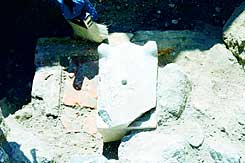Under the statue of a distinguished citizen
Ran Shapira

the foundation "There is no doubt: the residents of the city prayed to the Greek and Roman gods and knew the stories of Homer." Photo: Michael Eisenberg, Haaretz
Direct link to this page: https://www.hayadan.org.il/susita220803.html
In the forum of Susita, the heart of the Hellenistic city founded in the second century BC on the western slopes of the Golan Heights, a plinth was placed that was apparently intended to carry the statue of a distinguished citizen who made a special contribution to the city. Hundreds of foundations of this type were found in the cultural centers of the Greek and Roman world, which were very common in the cities of Greece and Asia Minor, aka Turkey.
The foundation from Sosita is the first found in Israel, says Prof. Arthur Segal from the Zinman Institute of Archeology at the University of Haifa. According to Prof. Segal, the foundation points to Susita's cultural identity. "Where such a foundation is found, there is no doubt: the city's inhabitants belonged to the Hellenistic culture. They prayed to the Greek and Roman gods, knew the stories of Homer, built according to Greek architecture, etc.
The establishment reinforces what is already known about Susita. The city belonged to the Decapolis, a group of cities with a Greek cultural color that were built in the second century in the Syrian region. Two of them, Beit Shan and Susita - or Hipos in its Greek name - are located in Israel.
The forum where the foundation was discovered was a square paved with basalt slabs and bordered by an avenue of columns (stio) that stood on marble plinths and bore a marble capital. The columns were found lying in the square of the forum. They collapsed in an earthquake that hit the city in 749 AD.
In the four seasons of excavation so far in Susita, a well-planned city was found in an excellent state of preservation. There were impressive public buildings in the place, built from local basalt bricks and limestone brought from afar. The buildings were decorated with different types of marble, which came to Sosita from different sites in the Mediterranean basin, a testament to the economic capacity of the city's rulers and the extensive trade relations they developed.
Susita also flourished during the Roman occupation and maintained its status during the Byzantine period, when five churches were built in the city. Two of the churches were excavated in the last season. In one of them, in the northwestern part of the city, a team from the Polish Academy of Sciences in Warsaw uncovered the prayer hall. A small marble box was found in the hall where the bones of some saint whose name remains unknown for the time being were kept.
In the territory of this church, a bronze urn from the ancient Arab period was found in the last season. According to the researchers, the urn provides proof that the church continued to function during the Arab occupation.
The second church excavated this year, in the northeastern part of the city, is the smallest and most modest among the churches in Susita. Despite this, she provided one of the biggest surprises in the digs last season. The members of the expedition from Concordia University in St. Paul, Minnesota found two graves next to the altar.
According to Prof. Segal, burial in a church is an extremely rare matter. Graves so close to the altar testify to the status of the people buried in them and it is possible that the graves were people who held high positions and maybe even local saints.
https://www.hayadan.org.il/BuildaGate4/general2/data_card.php?Cat=~~~613775937~~~158&SiteName=hayadan
